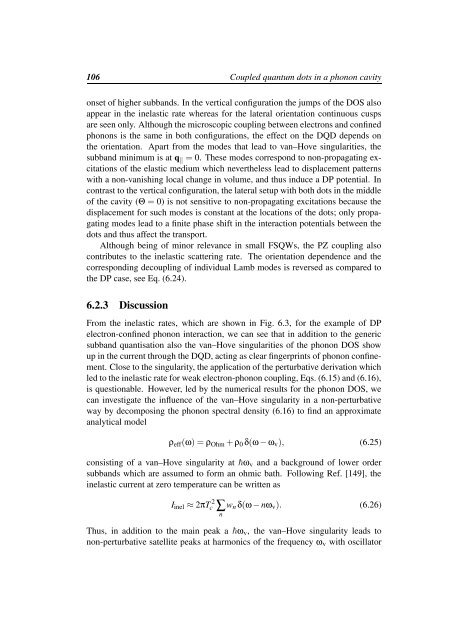Spin-orbit coupling and electron-phonon scattering - Fachbereich ...
Spin-orbit coupling and electron-phonon scattering - Fachbereich ...
Spin-orbit coupling and electron-phonon scattering - Fachbereich ...
Create successful ePaper yourself
Turn your PDF publications into a flip-book with our unique Google optimized e-Paper software.
106 Coupled quantum dots in a <strong>phonon</strong> cavity<br />
onset of higher subb<strong>and</strong>s. In the vertical configuration the jumps of the DOS also<br />
appear in the inelastic rate whereas for the lateral orientation continuous cusps<br />
are seen only. Although the microscopic <strong>coupling</strong> between <strong>electron</strong>s <strong>and</strong> confined<br />
<strong>phonon</strong>s is the same in both configurations, the effect on the DQD depends on<br />
the orientation. Apart from the modes that lead to van–Hove singularities, the<br />
subb<strong>and</strong> minimum is at q ‖ = 0. These modes correspond to non-propagating excitations<br />
of the elastic medium which nevertheless lead to displacement patterns<br />
with a non-vanishing local change in volume, <strong>and</strong> thus induce a DP potential. In<br />
contrast to the vertical configuration, the lateral setup with both dots in the middle<br />
of the cavity (Θ = 0) is not sensitive to non-propagating excitations because the<br />
displacement for such modes is constant at the locations of the dots; only propagating<br />
modes lead to a finite phase shift in the interaction potentials between the<br />
dots <strong>and</strong> thus affect the transport.<br />
Although being of minor relevance in small FSQWs, the PZ <strong>coupling</strong> also<br />
contributes to the inelastic <strong>scattering</strong> rate. The orientation dependence <strong>and</strong> the<br />
corresponding de<strong>coupling</strong> of individual Lamb modes is reversed as compared to<br />
the DP case, see Eq. (6.24).<br />
6.2.3 Discussion<br />
From the inelastic rates, which are shown in Fig. 6.3, for the example of DP<br />
<strong>electron</strong>-confined <strong>phonon</strong> interaction, we can see that in addition to the generic<br />
subb<strong>and</strong> quantisation also the van–Hove singularities of the <strong>phonon</strong> DOS show<br />
up in the current through the DQD, acting as clear fingerprints of <strong>phonon</strong> confinement.<br />
Close to the singularity, the application of the perturbative derivation which<br />
led to the inelastic rate for weak <strong>electron</strong>-<strong>phonon</strong> <strong>coupling</strong>, Eqs. (6.15) <strong>and</strong> (6.16),<br />
is questionable. However, led by the numerical results for the <strong>phonon</strong> DOS, we<br />
can investigate the influence of the van–Hove singularity in a non-perturbative<br />
way by decomposing the <strong>phonon</strong> spectral density (6.16) to find an approximate<br />
analytical model<br />
ρ eff (ω) = ρ Ohm + ρ 0 δ(ω − ω v ), (6.25)<br />
consisting of a van–Hove singularity at ω v <strong>and</strong> a background of lower order<br />
subb<strong>and</strong>s which are assumed to form an ohmic bath. Following Ref. [149], the<br />
inelastic current at zero temperature can be written as<br />
I inel ≈ 2πT 2<br />
c ∑<br />
n<br />
w n δ(ω − nω v ). (6.26)<br />
Thus, in addition to the main peak a ω v , the van–Hove singularity leads to<br />
non-perturbative satellite peaks at harmonics of the frequency ω v with oscillator
















